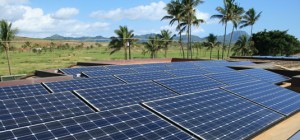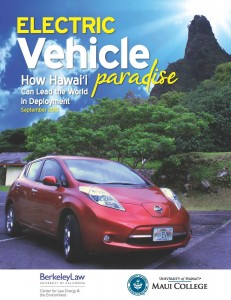Hawaii is the best state in America — when it comes to rooftop solar at least. With over 51,000 solar customers, the state has between 9 to 12 percent solar penetration on some islands, compared to a measly .5% nationwide. And it’s hard not to see why, from an economics perspective. Utility rates are some of the highest in the country, averaging more than 30 cents a kilowatt hour (and more on some islands). And the sun abounds in the islands, of course.
 The solar incentives are also fantastic: in addition to the 30% federal tax credit, the state offers a tax credit on up to 35% of a solar PV system or $5000, whichever is less. And with the “net metering” rate program in effect, solar customers get retail rate credit for surplus electricity they generate but don’t use on-site. At over 30 cents per kwh, that’s a good deal and a lot of credit.
The solar incentives are also fantastic: in addition to the 30% federal tax credit, the state offers a tax credit on up to 35% of a solar PV system or $5000, whichever is less. And with the “net metering” rate program in effect, solar customers get retail rate credit for surplus electricity they generate but don’t use on-site. At over 30 cents per kwh, that’s a good deal and a lot of credit.
So it’s no surprise then that the payback period for buying these systems is really short — 5 years average in Oahu and 4 years in Maui (California probably takes close to twice that time for a typical residential system).
But now Hawaii’s primary electric utility, Hawaii Electric Companies (HECO) (which serve Oahu, Maui, and Hawaii), wants to dramatically roll back the net metering program:
HECO filed a Transitional Distributed Generation (TDG) program Jan. 20 with the Hawaii Public Utilities Commission. … [T]he TDG program includes a cut in the value of the credit solar owners earn for the electricity their systems send to the grid. Instead of being credited at the retail electricity rate of $0.295 cents per kilowatt-hour (kWh), Oahu solar owners would get a TDG-estimated tariff rate of $0.147 per kWh; on Maui, solar owners would go from $0.351 per kWh to $0.223 per kWh; and on Hawaii, the credit would drop from $0.359 to $0.18.6 per kWh.
HECO says it will honor NEM agreements with current rooftop solar owners and those with pending interconnection applications.
In addition, HECO wants to install special inverters with new solar systems that will allow the utility to cut off the solar energy whenever they want to.
The plan is unfortunate in many ways. First, HECO and the Hawaii PUC have not yet thoroughly studied the benefits brought by all this distributed solar generation. Those costs and benefits should be quantified before new rates are adopted. Second, the rates do not reflect time of use, so they don’t encourage conservation or solar energy generation at times that would be most beneficial for the grid, in terms of reliability and cost savings. Finally, and somewhat related to #2, they don’t include any incentives for energy storage. A relatively small battery could store surplus solar for dispatch when the grid (i.e. HECO) really needs that power, thereby reducing the costs on the system from managing the power from these rooftop solar arrays. Right now those batteries are pricy, but HECO could greatly encourage people to purchase them if they knew there was a guaranteed and adequate revenue stream.
I hope this opening salvo from HECO is dramatically altered before it comes anywhere close to final. It’s easy to see the utility argument that net metered customers aren’t always paying their fair share for the grid, but this proposal fails to take into account what those costs might be and what specific policies might address them. The whole country has a stake in seeing Hawaii get these policies right and not jeopardizing the groundbreaking progress the state has made to date on solar.
Electric vehicles in Hawaii should be a no-brainer. The limited island geographies make battery “range anxiety” either easy to solve through a few public charging stations or practically non-existent. The high gas prices make driving economically painful. And the abundant renewable energy there (solar, wind, and geothermal) means lot of potential for cheap, clean electricity.
But the U.S. Department of Energy “eGallon” website shows a critical disconnect. In most states, the equivalent “miles per gallon” of using electricity instead of gas for driving results in huge savings. The average U.S. gallon of gas costs $3.52, while the equivalent cost in electricity is $1.27. Pretty nice amount of savings, no?
 Well, in Hawaii, we have an outlier result. The extremely high cost of electricity (most is generated from burning imported diesel), coupled with the high cost of gas, results in an unfortunate comparison: $3.79 for a gallon of gas vs. $3.75 in equivalent electricity costs. So you’ll save 4 cents per gallon going electric! Pretty weak.
Well, in Hawaii, we have an outlier result. The extremely high cost of electricity (most is generated from burning imported diesel), coupled with the high cost of gas, results in an unfortunate comparison: $3.79 for a gallon of gas vs. $3.75 in equivalent electricity costs. So you’ll save 4 cents per gallon going electric! Pretty weak.
That’s where rooftop solar comes into play. For residents of Hawaii with these systems, they can pay almost nothing in electricity through the state’s net metering program. This arrangement makes the savings from going electric probably greater than in almost any other state. In fact, in researching the report “Electric Vehicle Paradise” for Berkeley Law and Maui College last year, almost everyone I talked to who had purchased or leased an EV in the islands had rooftop solar. And they were motivated to go electric because they were producing too much solar from their roof.
That’s why our report recommended that Hawaii’s utilities, especially Hawaiian Electric (HECO), remove barriers to installing rooftop solar. At the time, the utility privately claimed to me that they really didn’t have any barriers, such as expensive interconnection studies. But shortly after we released the report they began clamping down aggressively on rooftop arrays with these studies.
But change is in the works. In response to an aggressive state public utilities commission directive, HECO now plans to go 65% renewable by 2030, which is great. But the utility wants to impose a fixed monthly charge of $55 on solar customers, which could undermine the economics of going solar. And HECO still needs to get rid of phony “interconnection studies” that can cost thousands of dollars for a property owner trying to install solar.
With rooftop solar, particularly in Hawaii, it’s not just about cleaning the electricity system — it’s about driving cleaner, too. Not to mention that more EVs ultimately boosts energy storage in the islands from repurposed electric vehicle batteries. So let’s hope HECO does the right thing, because the whole movement to a cleaner, cheaper energy system in Hawaii starts with solar.


